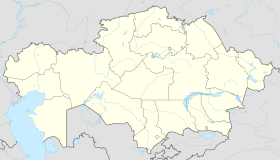Aral,_Kazakhstan
Aral, Kazakhstan
Place in Kyzylorda, Kazakhstan
Aral, also known as Aralsk or Aral'sk, (Kazakh: Арал, Aral, ارال; Russian: Аральск, Araljsk) 46°47′N 61°40′E is a small city in south-western Kazakhstan, located in the oblast (region) of Kyzylorda. It serves as the administrative center of Aral District. Aral was formerly a fishing port and harbour city on the banks of the Aral Sea, and was a major supplier of fish to the neighboring region. Population: 29,987 (2009 Census results);[1] 30,347 (1999 Census results).[1]
You can help expand this article with text translated from the corresponding article in Russian. (February 2009) Click [show] for important translation instructions.
|





